2008 Polaris Ranger RZR
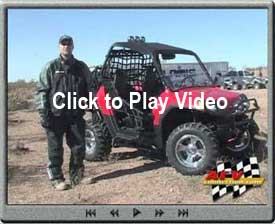
Readers, you are witnessing history in the making. Polaris completely blew the lid off the side-by-side ATV market by introducing a new ATV so revolutionary, and raising the bar so high, that it simply must define an all-new category of ATV – the Sport Recreational Utility Vehicle (SRUV). We predict that the new 2008 Polaris Ranger RZR (pronounced Razor) is going to change the face of the entire ATV industry for years to come.
We had an opportunity to test the amazing 2008 Polaris Ranger RZR, in the brutally rugged Arizona desert. One thing became very clear – you will not fully understand or appreciate the RZR until you drive it. Bold words, but true. The performance and ride experience of the RZR is nothing short of phenomenal. It is an extremely well engineered and well-executed design, with a fun-factor that may put you at risk of a permanent grin injury.
 |
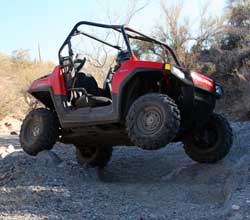 |
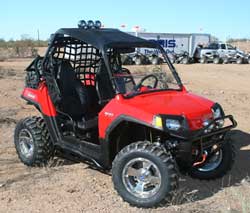
At a mere 50 inches wide, the RZR is the only truly trail capable side-by-side in its class. To put things in perspective, consider that the Can-Am Outlander is only 4 inches narrower than the RZR, yet the RZR comfortably carries two people seated side-by-side. The RZR is also the lightest side-by-side in the industry, weighing in at a featherweight 945 pounds. Couple the light weight, and narrow footprint, with the lowest cage height of any side-by-side in the industry – and you have the world’s most versatile side-by-side capable of reaching even the remotest of places.
Let’s take a closer look at why the RZR is special.
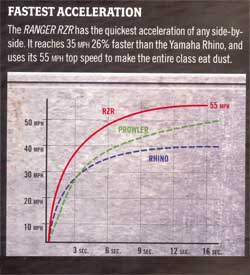
The Big Bore 800 (760 cc) Twin Cylinder 4-stroke engine provides the RZR with superb low-end torque, an impressive acceleration curve of 0-35 in about 4 seconds and a claimed top speed of 55 mph! In our ride tests, we found that the RZR offered all the power one could want – especially in such a nimble and lightweight package. Driving the RZR is a total blast. It didn’t take long to get comfortable with it. We quickly fell into a routine of charging into a corner, tapping the brake while pitching the wheel, and then hammering the throttle as we simply flew down the straights! The RZR ate up everything that we threw at it and it almost begged us for more. The RZR’s respectable power-to-weight ratio resulted in it easily outperforming every other side-by-side that we have tested in the past.
The big 4-stroke thumper is fed via an altitude and temperature compensating Electronic Fuel Injection (EFI) system. The lack of a carburetor means no jetting changes are necessary between driving at sea level or when driving in the mountains. Access to the engine compartment is easily achieved by popping out the two front seats and then removing an access panel. No tools are required, which is a real boon when on the trail.
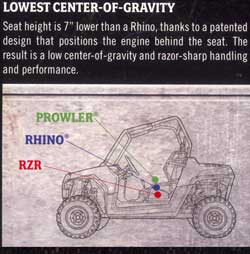
One of the keys to the incredible stability of the RZR is its very low center-of-gravity. Polaris engineers wisely located the engine low in the frame behind the front seats, but ahead of the rear axles. The riders do not sit on the engine. This gives the RZR the lowest center of gravity of any side-by-side and positions the riders 7 inches lower then on competitive side-by-side vehicles. Keeping all of the mass low in the frame, with a low CG, means that the RZR is very stable. Weight bias is about 45 percent to the front.
The transmission is a PVT (Polaris Variable Transmission) which was modified slightly for placement into the frame of the RZR. The engine and transmission mount to the frame using a 3-point vibration isolating mounting system. Gear range is engaged through the use of a floor-mounted shift lever which places the vehicle into Park, Neutral, Reverse, Low or High. The vehicle must be stopped whenever shifting.
 |
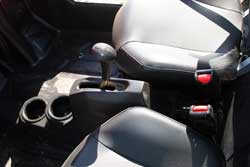 |
We were glad to discover during our testing that the shift lever offered plenty of mechanical advantage. At one point we were forced to stop on a very steep, downward, incline and to put the vehicle into park. This raised concern that it might be difficult to move the shift lever back into the “high” position – however, that was not the case. Operation of the shift lever was both smooth and positive on every occasion. While the RZR does not have a parking brake, Polaris assured us that when the RZR is placed into park, the driveline is locked in such a way that no parking brake is necessary.
Luckily, the RZR’s low center of gravity does not come at the cost of compromising ground clearance! The RZR has a full 10 inches of ground clearance, which came in mighty handy when we launched it over the top of some of the larger rocks in the test area. We never did manage to hang the RZR up on the frame, but that may have been due largely to the awesome traction, which kept the RZR constantly on the move.
 The biggest surprise we encountered when testing the RZR was the suspension system. We took the RZR over whoops that would have nearly swallowed a small Volkswagen — yet the RZR never once bottomed out nor did we experience the bone jarring “spinal tap” that sometimes happens when a suspension is moving up and your body is moving down.
The biggest surprise we encountered when testing the RZR was the suspension system. We took the RZR over whoops that would have nearly swallowed a small Volkswagen — yet the RZR never once bottomed out nor did we experience the bone jarring “spinal tap” that sometimes happens when a suspension is moving up and your body is moving down.
The wheelbase of the RZR is a little longer than that of a typical ATV, which results in a “smoothing out” of rough sections and whoops. It was downright pleasant to drive the RZR over any type of terrain regardless of how rough. Rider effort and fatigue is almost non-existent when driving the RZR over rough terrain.
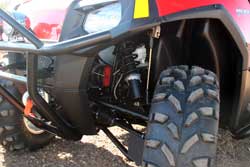 Exceptional suspension performance is also attributable to the 9 inches of suspension travel up front and 9.5 inches in the rear. The front utilizes an A-arm suspension with an anti-sway bar. The anti-sway bar prevents the front from “pushing” on corners or introducing any noticeable body roll. The rear features a “rolled” Independent Rear Suspension System (IRS), which also has an anti-sway bar. What Polaris means by a “rolled” IRS is that the wheels are canted backwards so that as the wheel travels upwards it also moves backwards — effectively elongating the wheelbase. They call this concept “recessional wheel travel.” The theory is that it allows the suspension to absorb far more shock than a traditional suspension system that typically only moves up and down.
Exceptional suspension performance is also attributable to the 9 inches of suspension travel up front and 9.5 inches in the rear. The front utilizes an A-arm suspension with an anti-sway bar. The anti-sway bar prevents the front from “pushing” on corners or introducing any noticeable body roll. The rear features a “rolled” Independent Rear Suspension System (IRS), which also has an anti-sway bar. What Polaris means by a “rolled” IRS is that the wheels are canted backwards so that as the wheel travels upwards it also moves backwards — effectively elongating the wheelbase. They call this concept “recessional wheel travel.” The theory is that it allows the suspension to absorb far more shock than a traditional suspension system that typically only moves up and down.
Polaris equipped the RZR with a true all-wheel drive (AWD) traction system. The AWD is enabled or disabled via a dash-mounted rocker switch. When enabled, the RZR senses wheel slippage and automatically engages the AWD. Then when traction is no longer needed, the system automatically reverts back to 2WD. Why would anyone ever want to disable the AWD via the switch? It’s Fun! In 2WD mode the RZR goes from cornering as-if-on-rails to being able to power slide and play!
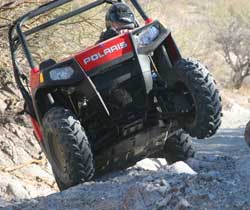 |
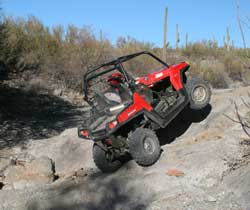 |
During our ride testing we appreciated the responsive, light and predictable, steering so much that we opted to leave the AWD engaged all the time. Its confidence inspiring to know that when you summit a treacherously steep foothill, and suddenly find a hairpin turn is the only thing between you and going over the edge, that a mere flick of the steering wheel results in a smoothly executed turn with little drift.
The AWD performed exceptionally well in every situation that we encountered. The RZR climbs like a mountain goat. In fact, we climbed hills that would have given us pause on a lesser machine. When faced with respectable-sized rocks blocking the trail, you merely drop the RZR into low gear and have at it. While conditions didn’t allow us to test the RZR in mud or snow, we have no reason to believe that the RZR wouldn’t shine equally well in those situations. Perhaps in the future we will have an opportunity to test in those conditions.
Polaris paid a great deal of attention to making the RZR both safe and comfortable. The door openings to the RZR are covered by a safety net that keeps the driver’s and passenger’s legs inside of the vehicle. In addition, the floor is located in what could be called a “deep well” — which means that there is a positive ridge in the door opening that would make it very difficult for a person’s legs to come out of the vehicle even in the unlikely event of a rollover.
Located on the outer sides of the seats, at both shoulder and hip level, is a series of tubular braces that add additional safety. These braces are designed to firmly hold the driver and passenger into the seats during heavy cornering or, again, in the unlikely event of a rollover. We found that they also offered a very secure feeling when operating the RZR.
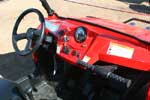 |
 |
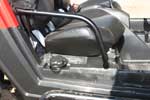 |
The Seats were very comfortable and were high enough to provide very good neck support. While the seats were not adjustable without tools, we found it unnecessary to adjust them from their stock location. However, a taller rider might want to set one seat for tall people and one for shorter people and then swap them around depending upon who was driving.
One of the most clever and unique safety items is undoubtedly the T-Bar handle located on the passenger’s side under the dash. The T-Bar is similar to an ATV handlebar. It provides a secure handhold for the passenger to hang onto during maneuvers and keeps the passengers hands inside of the vehicle out of harms way. The height (distance from passenger to T-Bar) is easily adjusted by removing a pin, sliding the T-Bar in or out, and replacing the pin.
The 3-point safety belts also had a unique feature in that they had about 2 inches of “give” to them that prevented them from tightening up when the passenger or driver were bouncing along on rough terrain. The driver’s side tilt steering wheel comfortably accommodated a wide variety of drivers.
The design on the dash instrumentation was very easy to read even in bright sunlight. One look would quickly provide you with information on speed, fuel level, gear selection, AWD status and a number of other important indicators. Another nice feature was a rocker switch on the dash, which would illuminate lights to the rear of the RZR where a person might be packing up their gear in the dark after a long day in the woods or on the ice.
We have talked a lot about the impressive performance offered by the RZR. However, its important to understand that this vehicle is not just meant for play. The RZR is capable of serious work both around the farm or hunting in the woods. Its rear cargo capacity is 300 pounds and the lock and ride bed has plenty of room for gas, a chainsaw and other gear. With a 1500 pound towing capacity, the RZR is capable of hauling firewood out of the woods or hay around the farm and a whole lot more. We think this vehicle will fast become the vehicle of choice for hunting guides who need to carry people and gear to remote locations.
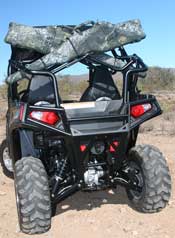 |
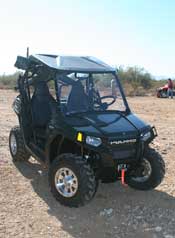 |
With the availability of a winch, light bars and bumpers, spare tire carrier, windshields, gun scabbards, cab roofs and even more accessories yet to be announced – you can see that the RZR is by far the most versatile side-by-side on the market today. Hence, you can see why we began this article with the statement that the RZR will change the face of the ATV industry.
What about the negative aspects of the RZR? In our 11 years of evaluating and testing ATVs we have never encountered a vehicle to which we couldn’t find at least one major design or performance flaw on which to report to you. Well, we’re embarrassed to tell you that it was really tough to find any aspect of the RZR which we could complain about. The Ranger RZR is simply that good. While it’s a credit to Polaris engineering, it certainly makes our job tough.
We only encountered one minor problem during our entire test when we ran into a situation where the lap belt wouldn’t release after it rewound into the spool mechanism. We had to remove a seat and the plastic cover over the belt spool mechanism before it released and before we could put the lap belt back on. The problem may have occurred because we were stopped on an extremely steep incline when we unbelted and got out of the vehicle. The mechanism may not have fully released due to the angle. None of the other test riders encountered the problem, nor did it happen to us more than once. Thus we attributed it to a minor fluke.
We will obtain a test vehicle in the future and if we have to destroy it in the process of trying to find something bad to tell you about it, we will. Honest!
In the mean time, you can look for the 2008 Polaris Ranger RZR to be available in limited quantities in late spring. It will initially be available in red and then later in green. MSRP is ,999 (US) and ,999 (Canadian).
- Engine: 4-stroke twin-cylinder
- Displacement: 760 cc
- Cooling: Liquid-cooled
- Carburetion: Electronic Fuel Injection
- Alternator: 500 watts
- Starting: Electric/12V-18 AH
- Transmission: Automatic PVT (Polaris Variable Transmission)
- Gear range: dual range (high / low) forward, neutral, reverse, park
- Suspension front: Double A-Arm w/Anti-Sway Bar
- Wheel Travel front: 9 inches
- Suspension rear: Rolled Independent w/Anti-Sway Bar
- Wheel Travel rear: 9.5 inches
- Front tire: 25 x 8 – 12 Maxxis
- Rear tire: 25 x 10 – 12 Maxxis
- Front brakes: Hydraulic Disc, Dual Piston Calipers
- Rear brakes: Hydraulic Disc, Single Piston Calipers
- Overall length: 102 inches
- Overall width: 50 inches
- Overall height: 69 inches
- Wheelbase: 77 inches
- Ground clearance: 10 inches
- Bed capacity: 42 inches x 22 inches. 300 Pounds
- Towing capacity: 1500 pounds
- Fuel capacity: 7.25 gallons (US)
- Dry weight: 945 pounds
- Multi-function Speedometer: Fuel, Speed, Hour Meter, Odometer, Trip, AWD Engagement Indicator, EFI Diagnostic Codes, Gear selection, Clock
- Color choices: Red, Green
- MSRP: ,999 (US), ,999 (Canadian)

